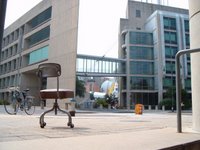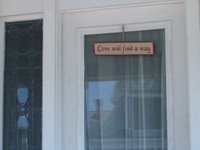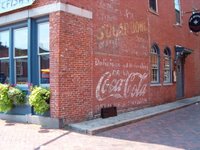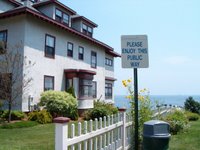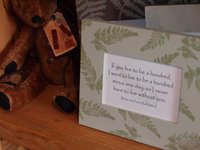Showing posts with label art. Show all posts
Showing posts with label art. Show all posts
02 March 2010
Do not mistake coincidence for fate.
Thank you to Presvytera Marion Turner for sharing this with me.
Labels:
art,
conspiracies,
favorites,
humor,
music,
Poetry,
song recommendations,
the sublime,
video
02 February 2010
Short documentary on Chris Marker
Chris Marker's short film, La Jetee (1962), was the inspiration for a song Thad Thompson and I wrote of the same name. His work is an all-time favorite of mine.
Labels:
art,
culture,
favorites,
film,
movie review,
science friction,
the sublime,
video
25 December 2009
Features: The Resurrection of the The Late BP Helium - Flagpole Magazine: Colorbearer of Athens, GA
 I just came across this article about my old friend, high school dance commander comrade, and band mate Bryan Poole in the Athens, GA Flagpole Magazine. He mostly plays with Of Montreal these days, but this article is about his solo projects. I'm especially psyched to link the picture. Read, listen, enjoy.
I just came across this article about my old friend, high school dance commander comrade, and band mate Bryan Poole in the Athens, GA Flagpole Magazine. He mostly plays with Of Montreal these days, but this article is about his solo projects. I'm especially psyched to link the picture. Read, listen, enjoy.Features: The Resurrection of the The Late BP Helium - Flagpole Magazine: Colorbearer of Athens, GA
Also, I just found this video interview. Fun stuff.
Labels:
art,
biography,
music,
science friction,
song recommendations,
video
"There ain't no Santa Claus on the evenin' stage"
So, for your viewing pleasure, here are a bunch of interviews with Don Van Vliet, better known to the world as Captain Beefheart.
1982:
A mix, with a later interview talking about his paintings (the 1982 interview repeats at the end):
And hey, here's a multi-part, BBC-produced documentary:
Part 2, Part 3, Part 4, Part 5, Part 6
"Don't know who he is? You're not alone":
Maker of banned television advertisements:
And finally, a late-career live performance of the title track (though this is an argued point) of the album Bat Chain Puller:
Merry Christmas, everybody.
1982:
A mix, with a later interview talking about his paintings (the 1982 interview repeats at the end):
And hey, here's a multi-part, BBC-produced documentary:
Part 2, Part 3, Part 4, Part 5, Part 6
"Don't know who he is? You're not alone":
Maker of banned television advertisements:
And finally, a late-career live performance of the title track (though this is an argued point) of the album Bat Chain Puller:
Merry Christmas, everybody.
Labels:
art,
Beefheart,
books-that-changed-my-life,
culture,
favorites,
music,
song recommendations,
video
02 May 2009
Of the Human and the Sublime
A few weeks ago, back in late March, I was in Manhattan for a conference and to visit with some old friends, and I had one of those moments that linger with you and affect you for a long time. In order to adequately describe it, I need to give a little context about myself and these sorts of "defining moments" that pop up every decade or so.
Years ago - a lifetime ago, really - when I was eighteen, some friends and I drove to Atlanta to see a show. We went to the Metroplex, a punk club in the heart of downtown Atlanta. It was 1988, and I think the Metroplex was on Moreland Avenue or somewhere like that. At any rate, we were there to see Fishbone. I hadn't seen many shows at that point in my youth. This night, however, would in many ways change and define my life.
The Metroplex was a fairly sizable club. It was rare in that, in addition to "the pit" (the area in front of the stage where the slamdancers "moshed") it had a balcony that circled three sides of the performance area. I was sitting in the balcony. That detail is important.
(The opener was the truly mighty Follow for Now. I remember they started their set out with an instrumental riff on the Rush song "Tom Sawyer" that opened a can of whoop ass in the room. But that just set the stage for what was to follow.)
To say that Fishbone was energetic would be an understatement. They started their shows hard, and then intensity just grew continually through the evening. The very first thing Angelo (the lead singer/saxophonist) did was run across the stage and dive into the audience, surfing on top of the crowd. The crowd, needless to say, was with the band from the first, and the spasmodic energy was palpable.
I have seen a lot of Fishbone shows in my time. One of the common threads to each was a point in the set where Angelo would induct the crowd into what they called the "Fishbone Familyhood." Though never exactly defined, the Familyhood was a sort of transracial love-fest. Ambassadors of goodwill to the cosmos, sort of like if the Deadheads moved faster and looked more like the Rainbow Coalition.
In most shows, the Familyhood induction speech happened from the stage, with Angelo leading the crowd, eventually, in a common "oath," of sorts, culminating in a chant: "Peace. Love. Respect. For everybody! Peace! Love Respect! For everybody!"
This night, however, when it came time for the Familyhood speech, Angelo had surfed the crowd to the back of the room. He had climbed one of the support columns beneath the second floor, and was now hanging from the balcony railing. He was less than ten feet from where we were sitting, and about fifteen feet above the floor below, hanging on with one hand while his other held the wireless microphone. Soon the whole crowd was chanting, "Peace! Love! Respect! For everybody! Peace! Love! Respect! For everybody!"...
...and Angelo leapt into the air, into the empty space above the crowd.
There is something about watching a human body hang in the void, even for a spit second, that stops your breath. I thought of this again, a few months ago, when Kira and I, along with our friend, Katy, went to the Belcourt to watch the award-winning documentary, Man on Wire.
There is a point, right at the end of the film, when - after all the preparation and intrigue, the planning and covert research that preceded Philippe Petit's tightrope walk between the Twin Towers of the World Trade Center - Petit mentions that he "made the decision to shift [his] weight from the building to the wire."
What follows is a slow series of still photos of Petit in the air, a quarter mile above the ground, as lilting strains of Eric Satie play without voice or comment. I have seen the film now several times, and the sight of this still stops me short and chokes me up. (If you have yet to see the film, see it. The moment is indescribably beautiful. Sublime.)
So on that day back in March I was walking around Central Park with my old friend Anson. I was feeling bummed because part of what I had planned to do during my visit to New York was to go see a play he was in, "Mourning Becomes Electra," but it had been canceled before the end of its run. Anson, however, was insisting that this was good, in fact, because this meant I now had a chance to go see what he claimed was "the best show in New York" at the time, "FuerzaBruta."
I'm not much for last minute schedule changes, so I was initially hesitant. Anson, however, was both enthusiastic and insistent, and I soon agreed. He made a call on his cellphone to another acquaintance of mine (who was in the show), and arranged to have a ticket discounted for me. Done.
A couple of hours later, I was on the subway heading south to Union Square, in the heart of Greenwich Village. After looking around a bit, I found the Daryl Roth Theatre, which apparently used to be an old bank. I stood in line, got my ticket (thank you, Jon!) and walked up the stairs as the show was just beginning.
How to describe FuerzaBruta? It was like that moment when Angelo leapt out over the crowd; it was like the moment in Man on Wire when Petit makes the decision to shift his weight from building to space; only it went on for more than an hour.
The performance space is cavernous. every inch of it was utilized - horizontally and vertically. The sweep of the themes and narratives (there is very little dialogue) is cavernous as well. The narratives are open-ended and infinitely interpretable. Horrifying, startling, liberating, exhilarating, euphoric... every moment brings a new possibility for feeling huge feelings. I have never seen anything like it. It was beautiful. Afterward, in fact, when discussing it with Anson and Jon (the performer who helped secure me the ticket), I said it was probably one of the most beautiful events I had ever seen. I meant it then, and I mean it now. Beautiful.
More than beautiful, though. The right word isn't "beautiful," I think. The right word here is "sublime."
The sublime was important years ago to folks like Shelley, Wordsworth and Lord Byron - Romantic poets dealt with the sublime. "The sublime has its source in the associated qualities of 'power,' 'vastness,' 'infinity,' and 'magnificence,'" M.H. Abrams wrote in his classic, Natural Supernaturalism, "and its characteristic effects on the beholder are the traditional ones aroused by the conception of the infinite power of a stern but just God: 'terror,' 'astonishment,' 'awe,' 'admiration,' and 'reverence.'"
You will think I am exaggerating, but this is not the case. Standing in the crowd at the Daryl Roth Theatre that evening, I felt those feelings. I think many around me felt them, too, though I am also certain that the range of responses was vast and unpredictable.
As I stood in the crowd, I thought of my Mother, who passed from this Earth the month before. I thought of how differently she and I saw things, and yet how we were still both able to be moved so deeply, in our own ways, by huge intangible things like "Beauty" and "Truth." It is a connection we shared, though our lives together had been been broken asunder by time and circumstance. Standing in that crowd, I missed her and mourned her, as I do now, typing this: in my own way. Death has a sublimity, too. But love, strange and broken and interpretable thought it may be, is still the stronger, in the end.
You will want me to link to video and show you pictures of what I saw that night. I will not. You will want to go to Google and look it up yourself. I cannot stop you, but I will say: you should not.
What I will tell you instead is that you should go to Manhattan. Get on a plane and go to Manhattan and get on the train and go to Union Square. Go the the Darryl Roth Theatre and buy your ticket and stand in the crowd and never forget that you are human. Frail and fragile and lost in the immensity of the universe you may be; but you are human... And it is wonderful to be human.
Angelo leapt into the air. The crowd reached up to him with its arms, and caught him.
Go to Manhattan.
Years ago - a lifetime ago, really - when I was eighteen, some friends and I drove to Atlanta to see a show. We went to the Metroplex, a punk club in the heart of downtown Atlanta. It was 1988, and I think the Metroplex was on Moreland Avenue or somewhere like that. At any rate, we were there to see Fishbone. I hadn't seen many shows at that point in my youth. This night, however, would in many ways change and define my life.
The Metroplex was a fairly sizable club. It was rare in that, in addition to "the pit" (the area in front of the stage where the slamdancers "moshed") it had a balcony that circled three sides of the performance area. I was sitting in the balcony. That detail is important.
(The opener was the truly mighty Follow for Now. I remember they started their set out with an instrumental riff on the Rush song "Tom Sawyer" that opened a can of whoop ass in the room. But that just set the stage for what was to follow.)
To say that Fishbone was energetic would be an understatement. They started their shows hard, and then intensity just grew continually through the evening. The very first thing Angelo (the lead singer/saxophonist) did was run across the stage and dive into the audience, surfing on top of the crowd. The crowd, needless to say, was with the band from the first, and the spasmodic energy was palpable.
I have seen a lot of Fishbone shows in my time. One of the common threads to each was a point in the set where Angelo would induct the crowd into what they called the "Fishbone Familyhood." Though never exactly defined, the Familyhood was a sort of transracial love-fest. Ambassadors of goodwill to the cosmos, sort of like if the Deadheads moved faster and looked more like the Rainbow Coalition.
In most shows, the Familyhood induction speech happened from the stage, with Angelo leading the crowd, eventually, in a common "oath," of sorts, culminating in a chant: "Peace. Love. Respect. For everybody! Peace! Love Respect! For everybody!"
This night, however, when it came time for the Familyhood speech, Angelo had surfed the crowd to the back of the room. He had climbed one of the support columns beneath the second floor, and was now hanging from the balcony railing. He was less than ten feet from where we were sitting, and about fifteen feet above the floor below, hanging on with one hand while his other held the wireless microphone. Soon the whole crowd was chanting, "Peace! Love! Respect! For everybody! Peace! Love! Respect! For everybody!"...
...and Angelo leapt into the air, into the empty space above the crowd.
There is something about watching a human body hang in the void, even for a spit second, that stops your breath. I thought of this again, a few months ago, when Kira and I, along with our friend, Katy, went to the Belcourt to watch the award-winning documentary, Man on Wire.
There is a point, right at the end of the film, when - after all the preparation and intrigue, the planning and covert research that preceded Philippe Petit's tightrope walk between the Twin Towers of the World Trade Center - Petit mentions that he "made the decision to shift [his] weight from the building to the wire."
What follows is a slow series of still photos of Petit in the air, a quarter mile above the ground, as lilting strains of Eric Satie play without voice or comment. I have seen the film now several times, and the sight of this still stops me short and chokes me up. (If you have yet to see the film, see it. The moment is indescribably beautiful. Sublime.)
So on that day back in March I was walking around Central Park with my old friend Anson. I was feeling bummed because part of what I had planned to do during my visit to New York was to go see a play he was in, "Mourning Becomes Electra," but it had been canceled before the end of its run. Anson, however, was insisting that this was good, in fact, because this meant I now had a chance to go see what he claimed was "the best show in New York" at the time, "FuerzaBruta."
I'm not much for last minute schedule changes, so I was initially hesitant. Anson, however, was both enthusiastic and insistent, and I soon agreed. He made a call on his cellphone to another acquaintance of mine (who was in the show), and arranged to have a ticket discounted for me. Done.
A couple of hours later, I was on the subway heading south to Union Square, in the heart of Greenwich Village. After looking around a bit, I found the Daryl Roth Theatre, which apparently used to be an old bank. I stood in line, got my ticket (thank you, Jon!) and walked up the stairs as the show was just beginning.
How to describe FuerzaBruta? It was like that moment when Angelo leapt out over the crowd; it was like the moment in Man on Wire when Petit makes the decision to shift his weight from building to space; only it went on for more than an hour.
The performance space is cavernous. every inch of it was utilized - horizontally and vertically. The sweep of the themes and narratives (there is very little dialogue) is cavernous as well. The narratives are open-ended and infinitely interpretable. Horrifying, startling, liberating, exhilarating, euphoric... every moment brings a new possibility for feeling huge feelings. I have never seen anything like it. It was beautiful. Afterward, in fact, when discussing it with Anson and Jon (the performer who helped secure me the ticket), I said it was probably one of the most beautiful events I had ever seen. I meant it then, and I mean it now. Beautiful.
More than beautiful, though. The right word isn't "beautiful," I think. The right word here is "sublime."
The sublime was important years ago to folks like Shelley, Wordsworth and Lord Byron - Romantic poets dealt with the sublime. "The sublime has its source in the associated qualities of 'power,' 'vastness,' 'infinity,' and 'magnificence,'" M.H. Abrams wrote in his classic, Natural Supernaturalism, "and its characteristic effects on the beholder are the traditional ones aroused by the conception of the infinite power of a stern but just God: 'terror,' 'astonishment,' 'awe,' 'admiration,' and 'reverence.'"
You will think I am exaggerating, but this is not the case. Standing in the crowd at the Daryl Roth Theatre that evening, I felt those feelings. I think many around me felt them, too, though I am also certain that the range of responses was vast and unpredictable.
As I stood in the crowd, I thought of my Mother, who passed from this Earth the month before. I thought of how differently she and I saw things, and yet how we were still both able to be moved so deeply, in our own ways, by huge intangible things like "Beauty" and "Truth." It is a connection we shared, though our lives together had been been broken asunder by time and circumstance. Standing in that crowd, I missed her and mourned her, as I do now, typing this: in my own way. Death has a sublimity, too. But love, strange and broken and interpretable thought it may be, is still the stronger, in the end.
You will want me to link to video and show you pictures of what I saw that night. I will not. You will want to go to Google and look it up yourself. I cannot stop you, but I will say: you should not.
What I will tell you instead is that you should go to Manhattan. Get on a plane and go to Manhattan and get on the train and go to Union Square. Go the the Darryl Roth Theatre and buy your ticket and stand in the crowd and never forget that you are human. Frail and fragile and lost in the immensity of the universe you may be; but you are human... And it is wonderful to be human.
Angelo leapt into the air. The crowd reached up to him with its arms, and caught him.
Go to Manhattan.
Labels:
art,
biography,
books-that-changed-my-life,
commentary,
critique,
culture,
essays,
favorites,
music,
strategies and hacks,
the sublime,
travel
30 March 2009
Yoko Ono - "Cut Piece"
Those of you who have been to my apartment may recognize these images. The framed poster in our front room is from this short film. If you are unfamiliar with this work, it is worth watching in its entirety. Yet another reason why Yoko is my favorite Beatle.
Labels:
art,
books-that-changed-my-life,
culture,
favorites,
film,
the sublime,
video
19 March 2008
21 December 2007
Diverting away from the narrative
So I have been meaning to get back to this topic of music videos for a while.
Months ago, I was reading an analysis of an Aphex Twin video written by Tom Gersic. His essay was the original impetus for the commentary on Ganxtaville I did a while back. For what follows here. I want to trace some common themes and interesting connections between a series of music videos that come from disparate periods and genres. I think that there is an aesthetic that can be outlined. So here we go.
One of my favorite videos of all time is Peter Gabriel's Shock the Monkey. One of the things I like best about it is how the images and the "narrative" of the song don't quite sync up. Gabriel "performs" the song, singing along with the music, but this is not a performance video. Instead, the song lyrics are woven into a disorienting set of images that menace the viewer (and Gabriel himself) both through their content and their disconnectedness:
Now, getting from here to Aphex Twin might take some work, but I see a line that can be drawn between them. At first it might seem like these are apples and oranges. However, I think Gabriel's video is a precursor in some key ways. It sets the stage, but there are some other elements as well to consider.
First of all, I recommend watching the following short clip from John Carpenter's late-model horror classic, The Prince of Darkness, as it gives a good example of another aspect of this aesthetic that I will define in a moment:
What we see above is a style with some identifiable features: 1) disturbing, unexplained images 2) shot in handheld video, with 3) diegetic but sub-audible or garbled voices speaking. It's freakin' creepy. I remember the first time I saw this film in the theater in high school with all my crazy pals. We laughed at a lot of it (it's pretty laughable) - but this part was disturbing.
Another example is the handheld footage incorporated into M. Night Shyamalan's Signs, when we first get a glimpse of one of the aliens. The combination of documentary-style with the uncanny is effectively disorienting (I don't have a clip to show, but the DVD is readily available). Both of these movie moments created a very particular feeling in me.
So that's one piece. Then, one night a couple years ago, I was traveling for my job with Outward Bound, and was staying the night at a hotel in Chattanooga. I couldn't sleep, and turned on the TV, and was flipping channels when I ran across the beginning of Paul Hunter's video for Marilyn Manson's The Dope Show:
As you can see, there is a resemblance to the aesthetic in Prince of Darkness I described above. But even more, there was a resemblance in the creepy feeling I had watching it. Needless to say, I did not sleep well in that motel room that night.
One last piece I want to add to the mix is the old David Bowie video for Ashes to Ashes. I think the similarities to the Manson video will be immediately obvious. The blown-out colors in Bowie's version are due to early video effects pushed into hot overdrive, but you can easily see how it influenced what's going on in the Manson video. Plus, note the strange chorus/entourage in black here that parallel the weirdos in Manson's limo. Also, this video is contemporaneous to Shock the Monkey, and offers a similar style of non-performance-performance and disturbing disconnectedness:
So now several pieces are in place. 1) In Gabriel's video, we have the "little people," attacking and biting Gabriel and menacing him inexplicably, and inexplicable interactions with presences who are not really "there," but move from film/video presence into "reality" with the "true" characters. 2) We have the documentary-style menace of John Carpenter - slanted handheld video and diegetic sub-audible voices, 3) we have the androgynous skinny-creepy creature of the Manson video, who seems alternately menaced and menacing in the "narrative," and 4) we have, in Bowie's video, the character of the "old woman," who in the Bowie video walks beside him on the "shoreline." We can see all of these elements resurfacing in the Aphex Twin clip.
Keeping these elements in mind, take a look now at the Aphex Twin video for Come to Daddy:
This is not, of course, to imply that Chris Cunningham's work here is not original and striking. On the contrary, it is a synthesis of the highest order, drawing all such elements together and bringing them forward in astonishing ways.
I don't have any grand conclusions to draw from all this. I just think these sorts of close readings are cool. A sort of genealogy, if you will, of these twenty-five years or so of visual music.
Hope you enjoyed them like I have. Thanks for watching.
Months ago, I was reading an analysis of an Aphex Twin video written by Tom Gersic. His essay was the original impetus for the commentary on Ganxtaville I did a while back. For what follows here. I want to trace some common themes and interesting connections between a series of music videos that come from disparate periods and genres. I think that there is an aesthetic that can be outlined. So here we go.
One of my favorite videos of all time is Peter Gabriel's Shock the Monkey. One of the things I like best about it is how the images and the "narrative" of the song don't quite sync up. Gabriel "performs" the song, singing along with the music, but this is not a performance video. Instead, the song lyrics are woven into a disorienting set of images that menace the viewer (and Gabriel himself) both through their content and their disconnectedness:
Now, getting from here to Aphex Twin might take some work, but I see a line that can be drawn between them. At first it might seem like these are apples and oranges. However, I think Gabriel's video is a precursor in some key ways. It sets the stage, but there are some other elements as well to consider.
First of all, I recommend watching the following short clip from John Carpenter's late-model horror classic, The Prince of Darkness, as it gives a good example of another aspect of this aesthetic that I will define in a moment:
What we see above is a style with some identifiable features: 1) disturbing, unexplained images 2) shot in handheld video, with 3) diegetic but sub-audible or garbled voices speaking. It's freakin' creepy. I remember the first time I saw this film in the theater in high school with all my crazy pals. We laughed at a lot of it (it's pretty laughable) - but this part was disturbing.
Another example is the handheld footage incorporated into M. Night Shyamalan's Signs, when we first get a glimpse of one of the aliens. The combination of documentary-style with the uncanny is effectively disorienting (I don't have a clip to show, but the DVD is readily available). Both of these movie moments created a very particular feeling in me.
So that's one piece. Then, one night a couple years ago, I was traveling for my job with Outward Bound, and was staying the night at a hotel in Chattanooga. I couldn't sleep, and turned on the TV, and was flipping channels when I ran across the beginning of Paul Hunter's video for Marilyn Manson's The Dope Show:
As you can see, there is a resemblance to the aesthetic in Prince of Darkness I described above. But even more, there was a resemblance in the creepy feeling I had watching it. Needless to say, I did not sleep well in that motel room that night.
One last piece I want to add to the mix is the old David Bowie video for Ashes to Ashes. I think the similarities to the Manson video will be immediately obvious. The blown-out colors in Bowie's version are due to early video effects pushed into hot overdrive, but you can easily see how it influenced what's going on in the Manson video. Plus, note the strange chorus/entourage in black here that parallel the weirdos in Manson's limo. Also, this video is contemporaneous to Shock the Monkey, and offers a similar style of non-performance-performance and disturbing disconnectedness:
So now several pieces are in place. 1) In Gabriel's video, we have the "little people," attacking and biting Gabriel and menacing him inexplicably, and inexplicable interactions with presences who are not really "there," but move from film/video presence into "reality" with the "true" characters. 2) We have the documentary-style menace of John Carpenter - slanted handheld video and diegetic sub-audible voices, 3) we have the androgynous skinny-creepy creature of the Manson video, who seems alternately menaced and menacing in the "narrative," and 4) we have, in Bowie's video, the character of the "old woman," who in the Bowie video walks beside him on the "shoreline." We can see all of these elements resurfacing in the Aphex Twin clip.
Keeping these elements in mind, take a look now at the Aphex Twin video for Come to Daddy:
This is not, of course, to imply that Chris Cunningham's work here is not original and striking. On the contrary, it is a synthesis of the highest order, drawing all such elements together and bringing them forward in astonishing ways.
I don't have any grand conclusions to draw from all this. I just think these sorts of close readings are cool. A sort of genealogy, if you will, of these twenty-five years or so of visual music.
Hope you enjoyed them like I have. Thanks for watching.
Labels:
art,
commentary,
critique,
culture,
essays,
music,
theory pr0n,
video
04 November 2007
01 November 2007
07 December 2006
Nashville Art: Past, Present and Future
The following is an article which I wrote which appears in the December 2006 issue of Nashville Arts Magazine.
It happened 25 years ago inChattanooga Atlanta Nashville
In other words, is theNashville
“There’s a real optimism inNashville right now,” says Herb Williams, who has become known in the Nashville Fifth Avenue
In the mid-1990’sAtlanta
“I think a tremendous impetus for the energy these galleries had was the 1996 Olympics,” says Robert Cheatham, now Eyedrum’s executive director. “A much wider range of demographics came intoAtlanta
What the Olympics brought toAtlanta
Tom Wegrzynowski, who is now finishing his MFA in painting at theUniversity of Alabama
During these years it was not unheard of that Nashville-based artists would leave forAtlanta Nashville Nashville to continue producing art in the same capacity, so I moved to Atlanta
ButAtlanta Atlanta
In many waysAtlanta Atlanta
Contrasts to this ‘hands off’ civic approach exist within a few hours’ drive in either direction fromNashville Chattanooga and Paducah Chattanooga Paducah , KY Paducah
“Cities likePaducah and Chattanooga are really embracing artists as an economic development booster,” says Caroline Carlisle of the Twist Gallery, one of the galleries making up the now-growing collection of storefront studio-gallery spaces in the Arcades on Fifth Avenue Arcade provides, they have to support it with their pocketbooks as well as with their presence.”
All the artists I interviewed, fromNashville
But those opportunities may disappear if there is not an equal commitment at the level of city government to create the economic and civic support to help give the arts living, breathing viability here. There are definitely efforts on the horizon, for example the Nashville Civic Design Center, which is a nonprofit organization founded in 2000 which seeks to foster public dialogue about the direction of Nashville’s civic space. Public art and the support of artists have played a part in these discussions. But there is also a history of resistance among city government officials to consideration of the kind of widespread commitment that would move us in the direction of artist-friendly cities likePaducah and Chattanooga
So what will happen inNashville Atlanta Atlanta Nashville
“We’ve got the momentum, the people, and the galleries all around town moving forward like never before,” Herb Williams says, summing it all up for me. “It’s now or never.”
Categories: culture
It happened 25 years ago in
In other words, is the
“There’s a real optimism in
In the mid-1990’s
“I think a tremendous impetus for the energy these galleries had was the 1996 Olympics,” says Robert Cheatham, now Eyedrum’s executive director. “A much wider range of demographics came into
What the Olympics brought to
Tom Wegrzynowski, who is now finishing his MFA in painting at the
During these years it was not unheard of that Nashville-based artists would leave for
But
In many ways
Contrasts to this ‘hands off’ civic approach exist within a few hours’ drive in either direction from
“Cities like
All the artists I interviewed, from
But those opportunities may disappear if there is not an equal commitment at the level of city government to create the economic and civic support to help give the arts living, breathing viability here. There are definitely efforts on the horizon, for example the Nashville Civic Design Center, which is a nonprofit organization founded in 2000 which seeks to foster public dialogue about the direction of Nashville’s civic space. Public art and the support of artists have played a part in these discussions. But there is also a history of resistance among city government officials to consideration of the kind of widespread commitment that would move us in the direction of artist-friendly cities like
So what will happen in
“We’ve got the momentum, the people, and the galleries all around town moving forward like never before,” Herb Williams says, summing it all up for me. “It’s now or never.”
Categories: culture
09 August 2006
Subscribe to:
Posts (Atom)

















